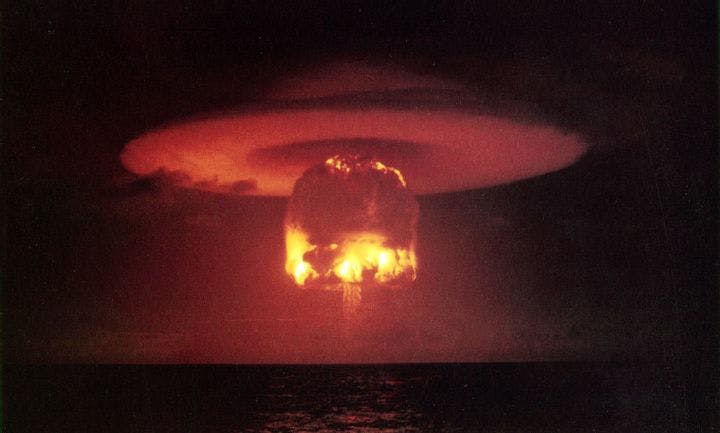Spring 2013
The rewards of being wrong about nuclear war
– The Wilson Quarterly
America’s Cold War wizards botched many predictions. But that was often for the better.
America’s intelligence experts and futurists were dead wrong about many of the big questions during the Cold War. At the outset, they badly underestimated how quickly the Soviet Union would be able to build its first atomic bomb, and they topped off their poor record decades later by failing even to imagine the Cold War’s end. Yet their work was invaluable, argue Matthew Connelly, a Columbia University historian, and his student coauthors in American Historical Review.
More than any other conflict, the Cold War put a premium on “prevision.” Nobody had ever fought a nuclear war before, so history provided little useful guidance, and if war broke out, events were expected to unfold so quickly and with such unprecedented violence that there would be little time to think. Ultimately, previsioning taught what history could not: Nuclear war was unthinkable.
After the Soviets exploded their first atomic bomb in 1949, U.S. intelligence turned its attention to determining the “moment of maximum danger” — the point when an aggressive Soviet Union would calculate that it had sufficient strength to launch a surprise attack on the United States. Many American strategists believed that communist ideology made such an attack nearly inevitable. After the Central Intelligence Agency was blindsided by the North Korean army’s surge across the 38th parallel in June of 1950 and again when Chinese and Soviet forces joined the fray the following November, alarmed U.S. officials moved the moment much closer. Air Force chief of staff General Hoyt S. Vandenberg put it just eight months in the future. He and others talked of launching a preemptive nuclear attack on the Soviet Union. Instead, the United States launched a massive military buildup that altered the perceived balance of power.
The stunning intelligence failures sparked harder thinking about a future nuclear war. In 1953, President Dwight D. Eisenhower launched the Solarium Project, naming three teams of experts to lay out competing long-term strategies. Eisenhower listened to the results in an all-day meeting and largely concluded that the preventive war favored by many strategists was out of the question. What would the world do if a vast part of it were left in ruins? “The only thing worse than losing a global war [is] winning one,” he declared.
America was learning to live with the Bomb — the emphasis would gradually shift from confrontation toward building a survivable nuclear deterrent force.
War planning nevertheless continued, with rounds of sophisticated computer simulations and, during the Kennedy administration, war games pitting U.S. officials against one another in role-playing exercises. After one such contest involving a hypothetical crisis over Berlin, the Americans realized that they would not be willing to go to war over the divided city because of the damage the Soviets could inflict. “It’s very hard to get a war started,” one wrote.
It wasn’t just the possibility of war that made thinking about the future a high-stakes enterprise. Envisioning future threats also translated directly into appropriations for weapons, fostering a new kind of futurist gamesmanship. Most early war games, for example, suggested that America’s strategic bombers would be destroyed on the ground by Soviet missiles. So in 1960 the Strategic Air Command successfully maneuvered to win responsibility for the nation’s nuclear war-fighting plan, the Single Integrated Operational Plan. Lo and behold, SAC’s computer simulations discovered new vulnerabilities in the Navy’s aircraft carriers and ballistic missile submarines, building the case for more B-52 and B-58 bombers. (In the 1970s, Andrew Marshall, head of the Pentagon’s Office of Net Assessment, reckoning that Soviet bureaucracies were just as flawed as American ones, cleverly baited Moscow into launching a needless and costly biological weapons effort.)
Previsioning had many ill effects, Connelly and his team concede. The United States built a huge nuclear arsenal, poised at hair-trigger levels, even though, as scholars learned after the Soviet archives were opened, there never were any plans for a surprise attack on the United States. Like their American counterparts, the Soviets had assumed that the enemy would be the aggressor. But the various forms of previsioning “helped regulate the relationship between the superpowers. Anticipating the future, perhaps even more than learning from the past, is what kept the Cold War cold.”
THE SOURCE: “‘General, I Have Fought Just as Many Nuclear Wars as You Have’” by Matthew Connelly, Matt Fay, Giulia Ferrini, Micki Kaufman, Will Leonard, Harrison Monsky, Ryan Musto, Taunton Paine, Nicholas Standish, and Lydia Walker. American Historical Review, Dec. 2012.
Photo courtesy of Wikimedia Commons
